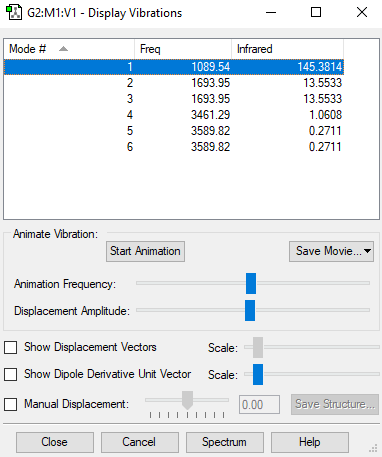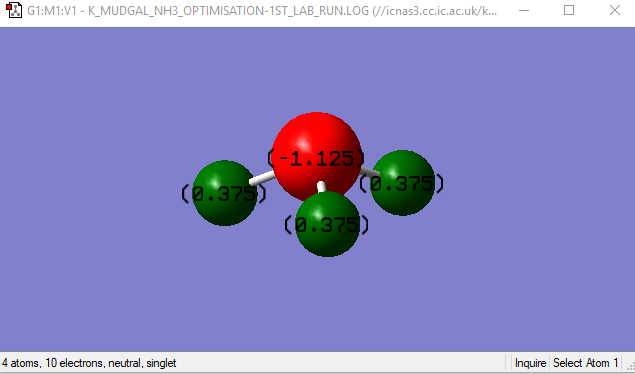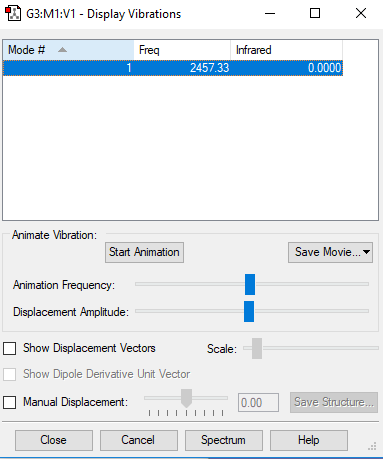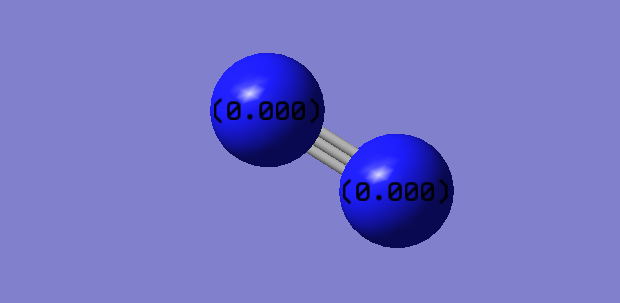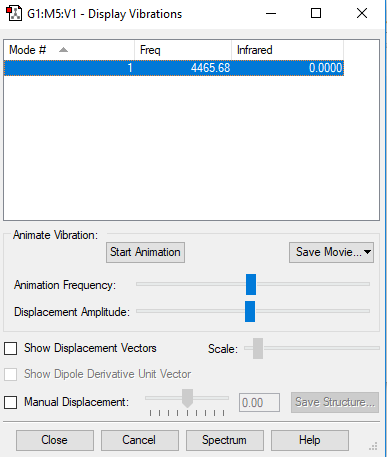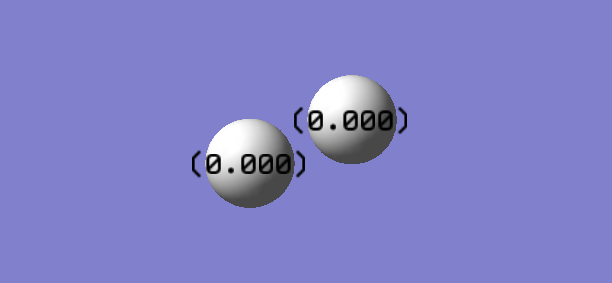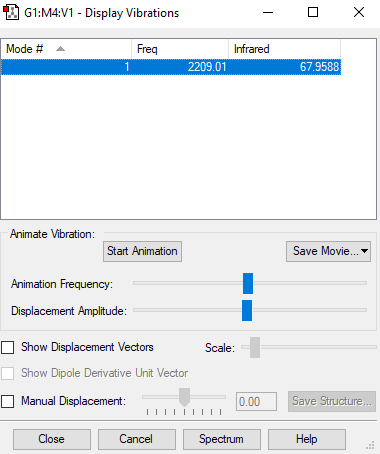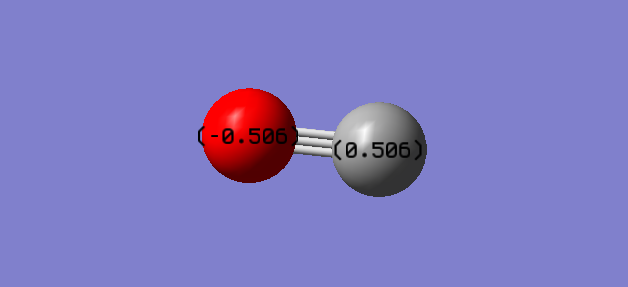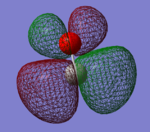Rep:Title=Mod:KartikMudgalComputationalNH3Analysis
NH3 Molecule
Molecule Information
| Name of Molecule | Ammonia |
|---|---|
| Calculation Method | RB3LYP |
| Basis Set | 6-31G(d,p) |
| Final Energy E(RB3LYP) in atomic units (a.u.) | -56.55776873 |
| RMS Gradient | 0.00000485 |
| Point Group | C3V |
| N-H Bond Length (Å) | 1.01798 |
| H-N-H Bond Angle (°) | 105.74115 |
Optimised Ammonia |
The optimisation file is linked to here
"Item Table"
Item Value Threshold Converged?
Maximum Force 0.000004 0.000450 YES
RMS Force 0.000004 0.000300 YES
Maximum Displacement 0.000072 0.001800 YES
RMS Displacement 0.000035 0.001200 YES
Predicted change in Energy=-5.986269D-10
Optimization completed.
-- Stationary point found.
Animating The Vibrations
| Wavenumber (cm-1) | Symmetry | Intensity |
|---|---|---|
| 1090 | A1 | 145 |
| 1694 | E | 14 |
| 1694 | E | 14 |
| 3461 | A1 | 1 |
| 3590 | E | 0 |
| 3590 | E | 0 |
Questions on Vibrations
From the 3N-6 rule, one would expect to see 6 vibrational modes. The degenerate modes are the modes with 1694 cm -1 and 3590 cm -1 wavenumbers. The bending vibrational modes are at 1090 cm -1 & 1694 cm -1. The stretching vibrational modes are at 3590cm -1 & 3461cm- -1. The highly symmetric modes are 3461 cm -1 and 1090 cm -1. The umbrella mode is 1090 cm -1. In the experimental spectrum of gaseous ammonia, one would expect to see 2 bands.
Picture of Charge Distrubution on Optimised NH3
The nitrogen would hold a negative charge whilst the hydrogen would be positive. This is because nitrogen has a greater electronegativity, hence it withdraws a greater amount of electron denisty and forms a partial negative charge on the nitrogen. A partial positive charge would resultantly be formed on the hydrogen, thus forming a neutral molecule overall.
N2 Molecule
Molecule Information
| Name of Molecule | Nitrogen |
|---|---|
| Calculation Method | RB3LYP |
| Basis Set | 6-31g(D,P) |
| Final Energy E(RB3LYP) in atomic units (a.u.) | -109.52412868 |
| RMS Gradient | 0.02473091 |
| Point Group | D∞h |
| Nitrogen Bond Length (Å) | 1.11 |
| Nitrogen Bond Angle (°) | No bond angle present |
Optimised Nitrogen |
The optimisation file is linked to here
"Item Table"
Item Value Threshold Converged?
Maximum Force 0.000001 0.000450 YES
RMS Force 0.000001 0.000300 YES
Maximum Displacement 0.000000 0.001800 YES
RMS Displacement 0.000000 0.001200 YES
Predicted change in Energy=-3.401074D-13
Optimization completed.
-- Stationary point found.
Animating The Vibrations
| Wavenumber (cm-1) | Symmetry | Intensity |
|---|---|---|
| 2457 | SGG | 0 |
Questions on Vibrations
N2 has one vibrational mode which is a symmetric mode. This vibrational mode is not IR active as there is no change in overall dipole moment.
Picture of Charge Distrubution on Optimised N2
H2 Molecule
Molecule Information
| Name of Molecule | Hydrogen |
|---|---|
| Calculation Method | RB3LYP |
| Basis Set | 6-31G(d,p) |
| Final Energy E(RB3LYP) in atomic units | -1.17853936 |
| RMS Gradient | 0.00000017 |
| Point Group | D∞h |
| H-H Bond Length (Å) | 0.74279 |
| H-H Bond Angle (°) | No bond angle Present |
Optimised Hydrogen |
The optimisation file is linked to here
"Item Table"
Item Value Threshold Converged?
Maximum Force 0.000000 0.000450 YES
RMS Force 0.000000 0.000300 YES
Maximum Displacement 0.000000 0.001800 YES
RMS Displacement 0.000001 0.001200 YES
Predicted change in Energy=-1.164080D-13
Optimization completed.
-- Stationary point found.
Animating The Vibrations
| Wavenumber (cm-1) | Symmetry | Intensity |
|---|---|---|
| 4466 | SGG | 0 |
Questions on Vibrations
H2 has one vibrational mode which is a symmetric mode. This vibrational mode is not IR active as there is no change in overall dipole moment.
Picture of Charge Distrubution on Optimised H2
Structure and Reactivity
Unique Identifier for the Complex: ABASUR
H-H bond length (Å): 1.00
Difference in H-H Bond Length between the crystal Structure and computational value (Å): 0.25721
The bond length of the H-H bond in the transition metal complex is 1.00 Å. The bond length is shorter in the gaseous H2 molecule than in the transition metal complex (Dihydrogen-(dihydrogen bis(3,5-bis(trifluoromethyl)pyrazolyl)-borate-H,N)-bis(tri-isopropylphosphine)-ruthenium ). This is because in the transition metal complex, Ru-H bonds are also formed with each hydrogen. The dz2 orbital of ruthenium overlaps with the bonding orbital of the H2 bond, thus withdrawing electron density from the bonding orbital to increase the bond length of the H-H bond in the complex. The dxy orbital of ruthenium also overlaps with the anti-bonding orbital to partially weaken the bond and thus further increase the bond length of the H-H bond as well. Hence the H-H bond length in the transition metal complex is longer than in the gaseous molecule.
It is also important to note that because we are using computational methods to analyse our molecular structures, there are going to be error which occur due to the limitations of this computational method. Using a better computational method which takes more parameters into consideration would yield a greater accuracy.
Energies of the Haber-Bosch Process
E(NH3)= -56.55777 a.u.
2*E(NH3)= -113.11554 a.u.
E(N2)=-109.52413 a.u.
E(H2)=-1.17854 a.u.
3*E(H2)=-3.53562 a.u.
ΔE=2*E(NH3)-[E(N2)+3*E(H2)]=-0.05579 a.u.
ΔE= -146.47848 kJ/Mol
As this is an exothermic reaction, the product formed is more energetically stable than the reactant. Therefore, the ammonia product is 146.48 kJ/Mol (2dp) more stable than the gaseous reactants (N2 and H2)
CO Molecule
Molecule Information
| Name of Molecule | Carbon Monoxide |
|---|---|
| Calculation Method | RB3LYP |
| Basis Set | 6-31G(d,p) |
| Final Energy E(RB3LYP) in atomic units | -113.30824232 |
| RMS Gradient | 0.03370421 |
| Point Group | C∞V |
| C-O Bond Length (Å) | 1.13794 |
| C-O Bond Angle (°) | No Bond Angle present |
Optimised Carbon Monoxide |
The optimisation file is linked to here
"Item Table"
Item Value Threshold Converged?
Maximum Force 0.000007 0.000450 YES
RMS Force 0.000007 0.000300 YES
Maximum Displacement 0.000003 0.001800 YES
RMS Displacement 0.000004 0.001200 YES
Predicted change in Energy=-2.221225D-11
Optimization completed.
-- Stationary point found.
Animating The Vibrations
| Wavenumber (cm-1) | Symmetry | Intensity |
|---|---|---|
| 2209.01 | SG | 67.96 |
Questions on Vibrations
CO has one stretching vibrational mode which is IR active as it results in a change in overall dipole moment. Hence one band should appear in its IR spectrum.
Picture of Charge Distrubution on Optimised CO
The oxygen has a greater electronegativity than the carbon, thus withdrawing a greater amount of electron density and resulting in a partial negative charge forming on the oxygen. The carbon would hold a partial positive charge.
Molecular Orbitals of CO
Marking
Note: All grades and comments are provisional and subject to change until your grades are officially returned via blackboard. Please do not contact anyone about anything to do with the marking of this lab until you have received your grade from blackboard.
Wiki structure and presentation 1/1
Is your wiki page clear and easy to follow, with consistent formatting?
YES
Do you effectively use tables, figures and subheadings to communicate your work?
YES
NH3 1/1
Have you completed the calculation and given a link to the file?
YES
Have you included summary and item tables in your wiki?
YES
Have you included a 3d jmol file or an image of the finished structure?
YES
Have you included the bond lengths and angles asked for?
YES
Have you included the “display vibrations” table?
YES
Have you added a table to your wiki listing the wavenumber and intensity of each vibration?
YES
Did you do the optional extra of adding images of the vibrations?
YES
Have you included answers to the questions about vibrations and charges in the lab script?
YES
N2 and H2 0.5/0.5
Have you completed the calculations and included all relevant information? (summary, item table, structural information, jmol image, vibrations and charges)
YES
Crystal structure comparison 0.5/0.5
Have you included a link to a structure from the CCDC that includes a coordinated N2 or H2 molecule?
YES
Have you compared your optimised bond distance to the crystal structure bond distance?
YES
Haber-Bosch reaction energy calculation 1/1
Have you correctly calculated the energies asked for? ΔE=2*E(NH3)-[E(N2)+3*E(H2)]
YES
Have you reported your answers to the correct number of decimal places?
YES
Do your energies have the correct +/- sign?
YES
Have you answered the question, Identify which is more stable the gaseous reactants or the ammonia product?
YES
Your choice of small molecule 4.5/5
Have you completed the calculation and included all relevant information?
YES
Have you added information about MOs and charges on atoms?
YES, overall very good explanations. For MO2 you could have been more clear that the effect on the overall bonding of the molecule is to increase the bonding. (You say it has an effect but you leave the reader to infer what the effect is, it may seem obvious but you should state exactly what you mean in scientific writing.)
Independence 0/1
If you have finished everything else and have spare time in the lab you could:
Check one of your results against the literature, or
Do an extra calculation on another small molecule, or
Do some deeper analysis on your results so far
No independent work found.

